In this SEMrush review, I’m going to put one of the best-known SEO tools available to the test.
I’m going to discuss how it stacks up in terms of:
Domain analysis
Keyword research features
Rank tracking
Backlink analysis
Link building tools
Site auditing
Ease of use
Pricing and value for money
Support
…and more!
I’ll start with an important question...
What is SEMrush?
Simply put, SEMrush is a product that helps you optimize your website for search engines. Founded in 2008 by Oleg Shchegolev and Dmitry Melnikov, it now features a large user base — over 5 million users, according to the company — and is one of the most popular SEO tools currently available.
SEMrush works by giving you a lot of information, which you can use to either:
create new web content that is likely to attract traffic
identify link-building opportunities
tweak technical aspects of your site content so that it achieves a higher search ranking.
For example, SEMrush can give you keyword suggestions (based on phrases you enter) that can be used as the basis for writing blog posts that are likely to perform well in search results.
It can also tell you how difficult it will be to rank for specific search phrases.
It also suggests websites that might be worth approaching for backlinks.
And it allows you to perform an “SEO audit” on your website to find out if there are any technical improvements you can make to it that will help you achieve better search results.
That’s just the beginning though — there are many other features provided by SEMrush that are designed to help you improve your site’s position in search results. I’ll go through these in depth below, highlighting all their pros and cons.
Let’s kick all this off this by looking at something called domain analysis.
Domain analysis
Most SEO projects start with some basic domain analysis. This means getting a simple overview of the ‘quality’ of a domain from an SEO point of view.
You typically perform domain analysis either on your own website — to see where SEO improvements could be made — or on a competitor’s, to see how difficult it will be to outrank them in search results (or to find ways to do so).
You might also perform domain analysis on a website in order to see if it’s worth approaching its owner for a link from his/her site to yours — this is because external links (or ‘backlinks’) from high-quality websites to your content can really boost its performance in search.
It’s really easy to perform domain analysis in SEMrush: you just enter a domain URL in its ‘domain overview’ section, and you get an immediate sense of how it’s performing in search results.

Semrush's ‘Domain Overview’ feature
Metrics provided include:
An ‘authority score’
The total number of visitors to the website per month
Total number of external links — backlinks — pointing to the website
Total number of keywords the website ranks for
Anchor text commonly used in links to the website
Top performing keywords
Display advertising stats
Competing websites
Of the above metrics, the one that gives you the quickest understanding of site quality is usually the ‘authority score.’
SEMrush calculates this based on:
backlink data (the number of links pointing to it)
organic search data, including organic search traffic and keyword positions
website traffic data (monthly visits).
The authority score used to be a bit buried in SEMrush’s interface, but recently it’s been moved front and centre of the domain overview section, giving you an immediate sense of what SEMrush thinks of a particular domain.
Now, what’s important to remember about the domain overview stats is that while the majority of them are based on hard data, the traffic figures are estimates — and my experience of them is that they are not madly accurate.
(I base this observation on comparing the SEMRush traffic estimates against Google Analytics data for websites that I have access to).
To be fair to SEMrush, the tool doesn’t claim that the traffic figures are 100% accurate, and actually gives you an estimate of how accurate its traffic stats for a particular site are likely to be (low, medium or high).
But interestingly, I’ve found that its competitor Ahrefs seems to fare a bit better in the accuracy stakes here, at least when it comes to comparing their traffic estimates against Google Analytics data that I have access to. (You can read our Ahrefs vs SEMrush comparison here.)
It’s best to treat the traffic stats in SEMrush as something that gives you an indication of site popularity — and doing so can help you put your site into context against those of your competitors, or identify sites that it’s worth approaching about backlinks.
The other metrics provided in SEMrush’s domain overview are extremely useful and help you gain some very valuable insights on both your own site and others.
Worth a particular mention is the ‘competitive positioning map’ which lets you see, at-a-glance, where a particular site fits into a particular market and how strong it is against its competitors.
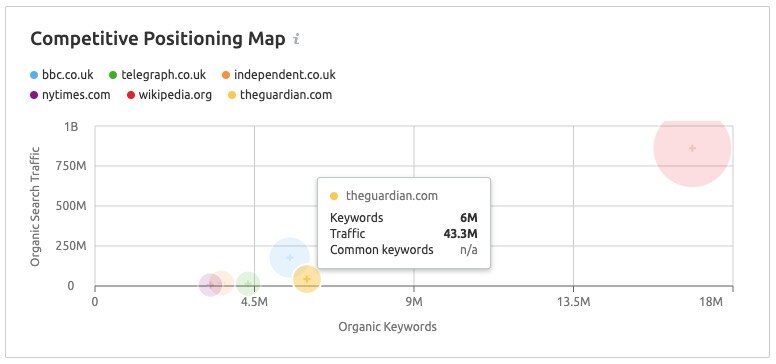
SEMrush’s ‘Competitive Positioning Map’ feature
The ‘keywords by country’ metric is also useful — it helps you get a sense of where in the world your site is ranking highly.
All in all, the domain overview section of SEMrush is extremely useful, and this aspect of the product on its own gives you a huge insight into how a website is performing from an SEO point of view.
Keyword research in SEMrush
Keyword research is generally about:
Establishing how many people are searching for a particular keyword
Establishing how difficult it is to rank for that keyword
Finding out who is already ranking for that keyword
Getting suggestions for other ones.
SEMrush makes it very easy for you to find out all the above information.
You just enter a keyword into its ‘Keyword Overview’ tool and you’ll immediately see
the number of searches per month for that keyword on Google
its ‘keyword difficulty’ score
a list of the sites that are ranking for it.
You can do this on a per country level too, which is helpful.

Getting a keyword overview in SEMrush
One of the most important metrics returned here is the keyword difficulty score. SEMRush uses a percentage to indicate this — with a higher percentage indicating that it’s going to be harder to rank for a particular keyword.
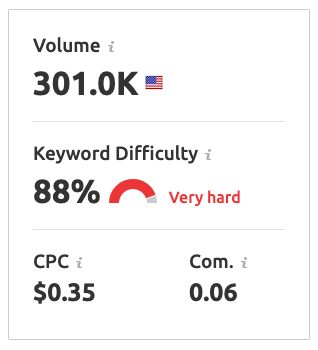
Semrush’s keyword difficulty score
To get keyword suggestions based on the phrase you’ve entered, you need to use SEMrush’s ‘Keyword Magic’ option.
From a usability point of view, it would be better if this was simply called ‘Keyword Suggestions’ — ‘Keyword Magic’ sounds a bit vague — but once you’ve accessed this part of SEMrush, you’ll find it’s very easy to use.
It provides you with a list of keywords that are related to the phrase you entered, along with filters that you can use to sort them, including:
the keyword difficulty
the number of searches per month for each keyword
the cost per click if you were to use Google Ads to display results for each keyword shown.
All in all, SEMrush’s keyword difficulty tool provides you with all the key information you need to make decisions on which keywords to target as part of an SEO project.
However, there are a couple of improvements that could be made to it.
First, the data provided is for Google searches only — it would be better if metrics were available for some other search engines.
To be fair, the overwhelming majority of searches continue to be made on Google (92% at time of writing, according to Statcounter) — but there are territories, not least the USA, where other search engines enjoy more use (in the US, for example, 7.2% of searches are currently made on Bing). Competing products such as Moz and Ahrefs give you access to this data.
Second, it would be good to get an indication from SEMrush regarding the number of backlinks you’ll need to rank for a particular keyword. One of the best things about keyword research in competing product Ahrefs is that it tells you exactly that — it would be good to see SEMrush follow suit.
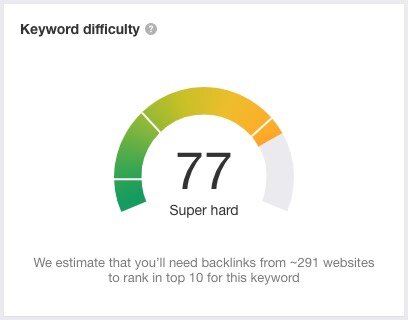
Ahrefs’ keyword difficulty score — note the useful information provided about how many backlinks you might need to rank on the first page of search results. It would be good if SEMrush provided this information too - as things stand, it doesn’t.
SEMrush's Content Marketing Toolkit
In addition to providing keyword research tools, SEMrush also provides you with a suite of content marketing tools (so long as you are on a 'Guru' plan or higher).
These allow you to:
- identify new topics to write about
- audit your existing content from an SEO point of view
- identify keywords that your comeptitors are using in their posts
- monitor mentions of your brand.
Once you've done that you'll get suggestions on ways you can improve its performance in search results. These include encouragements to increase or decrease word count; recommendations that you add certain keywords to your text; and warnings if your content looks like it has been scraped from other sites.
However, it would be nice to be able to simply paste a URL from your site in and get these suggestions — the copy/paste thing is a bit annoying.
Rank tracking
Rank tracking is the process of monitoring how your website performs in search engines for a particular keyword over time.
It’s easy to set this up in SEMrush — you go to its position tracker section, enter a domain name and the keyword(s) you’d like to track, and you get a report showing you how your site is currently ranking for those keywords. As time goes on, and more data about your site flows into SEMrush, you’ll be able to monitor the progress of your attempts to rank more highly for your chosen phrases.
You can also enter competitor website data into SEMrush’s position tracker tool, which allows you to compare (again, over time) how your site is performing for chosen keywords against those of your competitors. And finally, you’ll get regular email updates on your rank tracking progress.
All in all, the rank tracking functionality in SEMrush is strong — no complaints here.
Backlink analysis
How well a site performs in search results very much depends on how many backlinks — external sites linking to it — exist for the site in question.
There are two ways to go about looking at backlinks in SEMRush: the first is to use its ‘backlink analysis’ option, and the second is to perform a ‘backlink audit.’
Let’s look at each in turn.
Backlink analysis
SEMRush’s ‘Backlink Analytics’ section lets you enter a domain name and view a list of all the backlinks it can find to it.
You can also use this section to view:
the anchor text used for each backlink
Top-level domain distribution (how many .com, .org., .gov links etc. your site has)
information on the IP addresses of backlinks
All the information is laid out very clearly, and lets you see when a domain has attained or lost backlinks, along with the value of the links in question. You can use this information to inform your own SEO efforts, or gain insights into a competitor’s.

Backlink analytics in SEMrush
How accurate SEMrush’s backlink analysis is, of course, depends on the size and quality of its link database. At time of writing, SEMrush claims to have 31.3 trillion backlinks in its database, which if accurate compares positively with competitors Majestic, which claims 9.3 trillion, and Ahrefs, which claims 26 trillion.
(I couldn’t find equivalent data for Moz).
If these figures are correct, this makes the SEMrush link database larger than those of key competitors, which means in theory you should get more comprehensive backlink data from the tool.
I was curious however to see how this played out in some real-world tests, so I ran backlink audits on six quite different sites to see how some of the major tools fared against each other in this area.
In my (admittedly small-scale) test, I found that the number of backlinks found by each tool was pretty similar, with SEMrush performing better on websites with a smaller number of domains linking to them — it identified more linking domains than competing products Ahrefs or Moz.
However, Moz seemed to perform better where sites with bigger backlink profiles were concerned.
As this was just a small test, it’s hard to draw firm conclusions from it — but if there is a trend to be discerned, it’s that SEMrush’s large link database doesn’t automatically translate into surfacing a bigger number of linking domains. But it definitely provides you with a very comprehensive set of results which is broadly comparable to its key competitors.
Backlink audits
The other way to look at backlinks in SEMrush is by performing a ‘backlink audit’. The core purpose of doing this is to establish the ‘toxicity’ of backlinks pointing to your site and determine its ‘site health’.
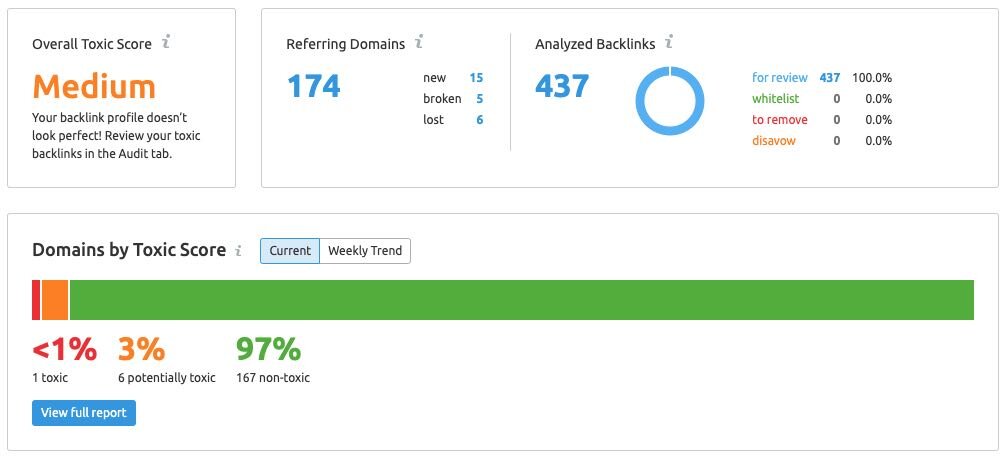
Identifying toxic links in SEMrush
During a backlink audit, SEMrush compiles a list of links that it thinks are spammy, which you can then review and upload to Google as a ‘disavow’ file. This effectively tells Google to ignore these toxic links — and, because Google penalises sites with lots of poor-quality links pointing to them, disavowing bad links can have a very beneficial impact on your search rankings.
(Note however that it’s important to tread very carefully when it comes to disavowing links — read Google’s guidelines on the topic before doing so!).
Ultimately SEMrush’s backlink audit tool is a very strong feature of the product. It’s really good at spotting poor-quality links and makes it really easy for you to prepare a disavow file for upload to Google.
You also get the option to whitelist the links too, if you feel that SEMrush has been over-zealous in identifying a link as toxic.
Link building in SEMrush
One of the standout features of SEMrush is its link building tool.
As mentioned above, link building — the process of getting other sites linking to yours — is absolutely vital to the success of any SEO project, because search engines typically reward sites with more links pointing to them with higher positions in search results (so long as the links in question are located on high-quality, relevant websites).
SEMrush’s link building tool works by
determining who your competitors are and what they’re ranking for
examining the content on your site
asking you the keywords you want to rank for
and then surfacing a list of ‘prospect’ websites that it thinks is worth approaching for a backlink or guest post opportunity.
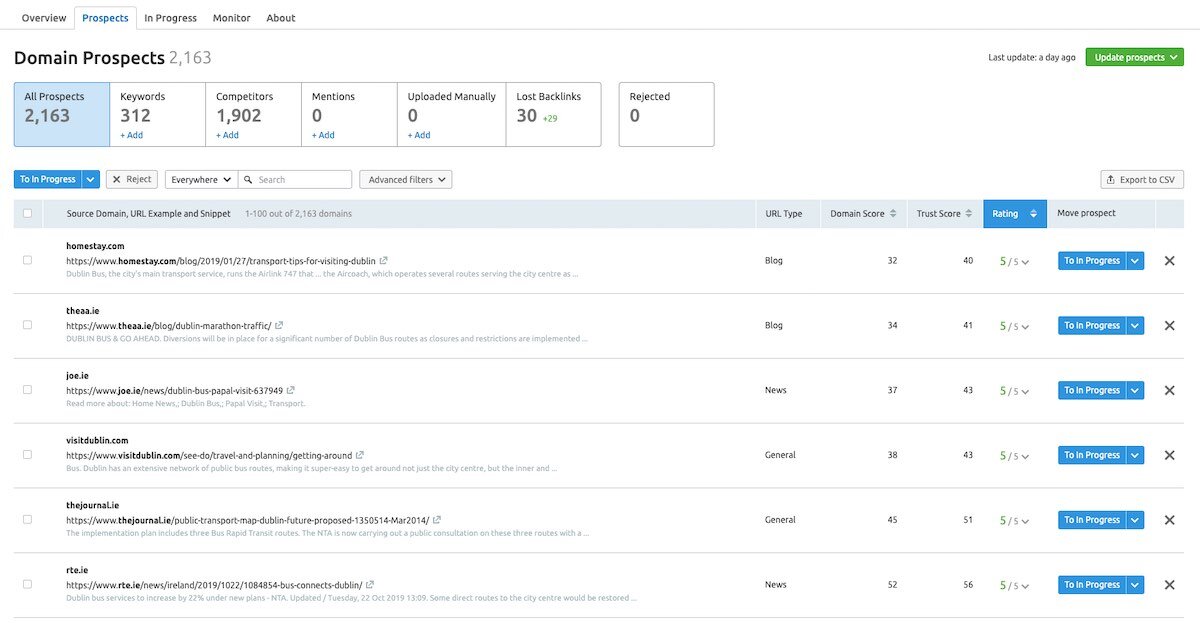
Domain prospects in SEMrush
Not only that, but it provides you with some extremely useful tools for doing so. You can connect your mailbox to SEMrush and send outreach emails from within the tool.
You can then keep tabs, CRM-style, on the progress of each approach.
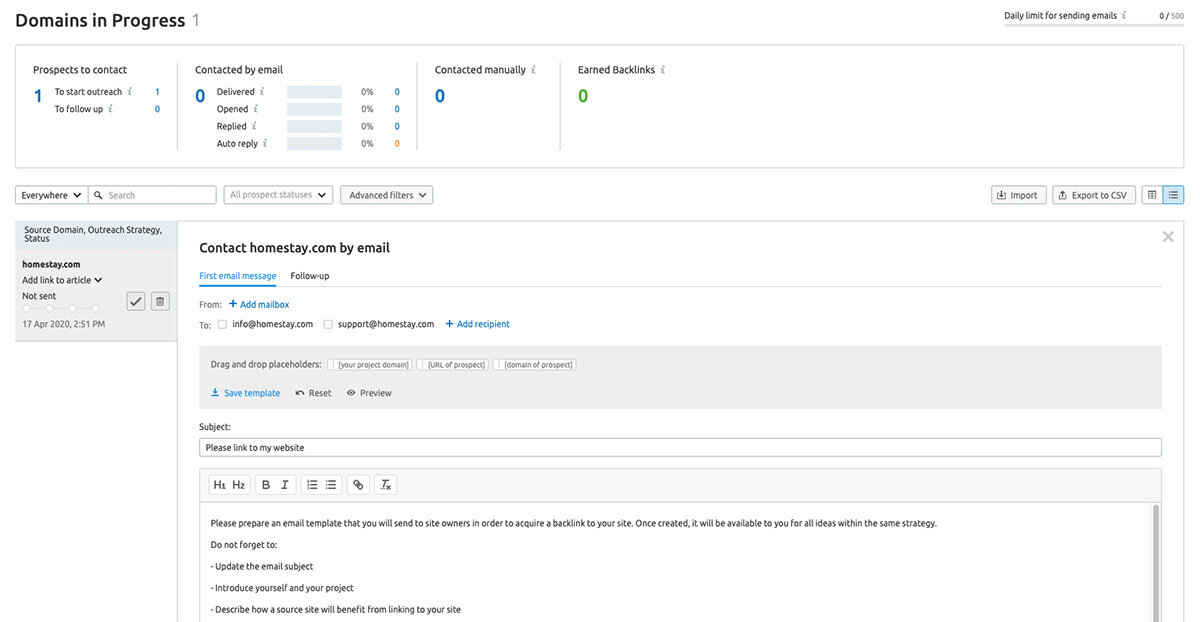
The tools provided for link building outreach are some of the best features of SEMrush.
If that wasn’t enough, where possible SEMRush even provides you with email addresses for each website, and the option to save an outreach email as a reusable template (see screenshot above).
All this goes well beyond anything that’s offered by SEMrush’s key competitors in the link-building department; and it’s arguably the strongest argument for using SEMrush over them.
Broken link building
Broken link building is a related — and very important — SEO tactic: it involves finding a broken link (i.e., one that no longer leads anywhere), recreating the ‘dead’ content that it used to point to, then asking anybody who used to link to the dead content to link to yours instead.
This approach allows you to build up new backlinks to your content — and as mentioned previously, the more backlinks that point to your website, the better your content performs in search.
SEMrush’s broken link building feature is less easy to get at than I’d like — you need to perform a full backlink audit on a competitor’s website, and then click a checkbox to identify URL errors — but it’s very sophisticated, because you can move any broken links into an outreach list which you can use to contact domain owners with.
The same ‘CRM-style’ features discussed above are available to help you here, which makes this task a lot less arduous than it could be.
Getting an extended free trial of SEMrush
The standard free trial of SEMRush lasts seven days — however, for a limited time, you can avail of an extended 14 day trial. This gives you a 14-day window to try out all the product’s key features and access all the data provided by SEMrush.
Site auditing
Another hugely useful feature of SEMrush is its site auditing functionality.
During a site audit, SEMrush will look out for issues which might be having a negative effect on your search ranking, including:
Slow-loading content
Duplicate content
SSL problems
Crawl errors
Missing headers
Overuse of keywords
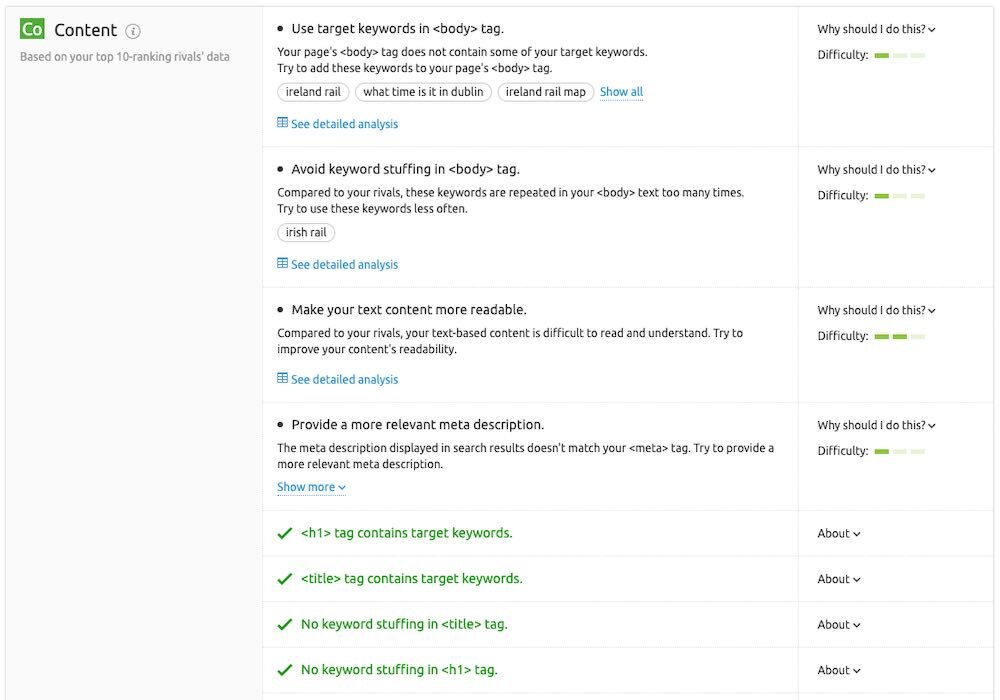
Checking on-page SEO in SEMrush
I particularly like SEMRush’s on-page SEO checker, which scans your entire website and gives you actionable tips for improvement for each page (in order of priority). These can include suggestions on
which keywords to add
steps you can take to make a page appear as a Google ‘featured snippet’
how to improve your body copy and meta descriptions
which websites to approach for backlinks
length of content
internal linking strategies…
...and much more.
Another thing that’s great about SEMrush’s site auditing features is that it doesn’t just tell you what to do, it tells you why you should do them.
A ‘Why should I do this?’ link accompanies each suggestion, and when clicked, explains in plain English the rationale behind each recommendation. You can learn a lot about SEO simply by reading these tips.
The site audit feature is simply superb and, as with SEMrush’s link building features, outclasses similar offerings from competing tools.ust enter your details below. Privacy policy.
Interface and ease-of-use
The SEMrush interface is similar to those of competing products like Moz and Ahrefs, comprising a menu of options on the left which you use to access functionality on the right. The menu options are grouped together in useful categories — competitive research, keyword research, link building, rank tracking, on-page SEO and reporting.
There is a lot of data to contend with — this may feel overwhelming at first, but you soon get used to it (and the point of tools like SEMrush is, of course, to provide you with a lot of data).
Additionally, the data visualisation that SEMrush provides helps you get over this sense of data overload — most of the metrics provided are graphed in ways that make the information much easier to understand.
It would be nice however if SEMrush’s interface could be made to work better with mobile phones — as things stand, it’s not ‘responsive’, meaning that if you log into SEMrush on a mobile device, you see the standard desktop interface, which means very small text and a lot of pinching and zooming.

Using SEMrush on a mobile phone requires a lot of pinching and zooming.
On the plus side, there is a mobile app available from SEMrush which allows you access your position tracking data; it would be better however if it gave you access to the other SEMrush features in a mobile-friendly format.
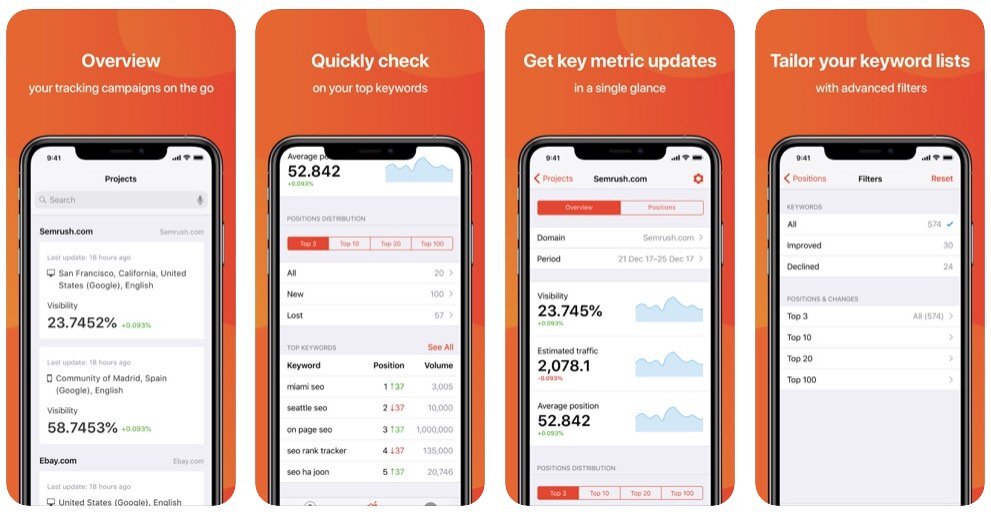
SEMrush’s mobile app for rank tracking.
Overall, SEMrush’s interface is laid out in an intuitive fashion and is straightforward to use — but you will need to be using a desktop computer rather than a mobile device to get the most out of it.
Pricing and value for money
Compared to other types of ‘SaaS’ (software as a service) apps, SEO tools like SEMrush are expensive.
That’s understandable however, as you’re not just paying for functionality, you’re paying for access to really large quantities of data, including competitor intelligence.
SEMRush offers 3 main pricing plans:
Pro: $99.95 per month
Guru: $199.95 per month
Business: $399.95 per month
There’s also an ‘enterprise’ version of the platform to consider — this allows corporate customers to create custom plans (with more generous limits on reports and queries, more user accounts etc.).
It’s important to note that if you want to check SEMrush out before committing to a paid-for plan, a free trial is available — the standard version lasts 7 days, but for a limited time you can access an extended 14-day one here.
In terms of how the free trial compares to those offered by competitors, it’s better than Ahrefs’ offering (a paid-for 7 day trial) but less generous than Moz’s (a 30-day free trial). You have to enter your credit card details to avail of the trial, which — whilst common enough practice where SEO tools are concerned — is a bit annoying.
Semrush’s fees are broadly comparable to those charged by key competitors Moz, Ahrefs and Majestic (that said, Majestic offers a lower monthly plan for $49 per month, but it is considerably less functional than the entry level plans provided by its competitors).
The main differences between the plans involve:
the number of reports you can run per day
the number of keywords you can track per month
access to content marketing tools
access to historical data.
Let’s zoom in on a few aspects of the pricing structure to highlight where SEMrush offers good — or bad — value for money.
Seats
Probably the worst thing about SEMrush’s pricing structure is that all plans — even the $399.95 ‘Business’ plan — only include one user account or ‘seat.’ If you want more than one person in your organization to have access to SEMrush, you’ll need to pay $70 to $140 extra, per user (depending on plan type).
And, just as annoyingly, there are caps on the number of seats per plan — only the ‘Business’ plan lets you add more than 2 users (the total user cap on this plan is 9).
This compares negatively with all its key competitors, who generally increase the seat count as you go up the pricing ladder (especially Moz — even on its entry level plan you get 2 seats included, and on its mid-tier plan you get 10).
If this is an issue for your organisation, you may need to investigate an ‘Enterprise’ plan with SEMrush — this allows you to negotiate pricing for a custom solution.
Projects
It’s important to be aware that the site auditing and backlink building features can only be used on domains that have been added as ‘projects’ in SEMrush.
How many projects you can have on the go depends on the SEMrush plan you’re on — but the entry level plan, at $99 per month, only facilitates 3.
This limitation won’t necessarily be a showstopper for every business — but if you have several sites that you need to manage SEO for concurrently, or do a lot of competitor analysis, it is something to be aware of.
Report requests
SEMrush is very generous when it comes to the number of reporting requests you can make each day: even on its $99 entry-level plan, you can pull 3,000 domain analysis reports per day — this massively outnumbers the 25 reports you can run per day on the Ahrefs entry level plan, for example.
This comparative generosity continues as you go up the pricing ladder: the SEMrush report daily limit for its $399 plan is 10,000; the Ahrefs $399 plan’s limit is just 250.
Competitive intelligence
There are quite a few SEMrush features for analysing competitors’ websites that are not available without purchasing a ‘competitive intelligence’ add-on.
These are:
Market Explorer (market players, market shares, audience age, gender and behavior, seasonal peaks, etc.)
Extended traffic analytics (visitor engagement, traffic sources, desktop and mobile, audience overlap, historical data, geographical information.)
Competitor benchmarking (the ability to cross-compare up to 5 competitor websites).
Bulk traffic analysis (web traffic data on up to 200 prospects in a click)
Top pages (web traffic data on up to 200 prospects in a click).
Rather disappointingly, this add-on costs $200 per month. To be fair, most of the above metrics could be considered worthy of paying a bit extra for, but $200 per month feels rather steep.
PPC data
If you’re working on a mix of SEO and PPC projects, you may find that SEMrush represents better value than some of its competitors.
This is simply because it features more PPC data — whereas other tools give you basic CPC figures for individual keywords, SEMrush goes beyond far this, giving you detailed CPC competition and distribution data, live ads and PPC campaign planning tools.
Support
SEO tools like SEMrush tend to be quite complex in nature, so the availability and format of customer support is a key consideration for prospective users.
The good news is that you get three channels of customer support with SEMrush: phone, email and chat. This contrasts positively with competing products, not all of whom offer phone support (Moz doesn’t even offer live chat support).
One improvement that could be made here is improving the visibility of the ‘contact support’ options — you have to scroll down to the footer to find the relevant details (it would be better if the floating ‘have a suggestion’ box was a ‘need technical support?’ box instead).
But to be fair to SEMrush, at least the footer contains a prominent phone number and email address — and unlike a lot of other online apps, you aren’t forced to search a knowledge base before being allowed to view a phone number.
SEMrush review conclusions
Overall, SEMrush is a really solid SEO tool that gives you all the key data you’ll need for a successful SEO project. Its standout features are its link building and site auditing tools; the former gives you an excellent ‘CRM’ style method of building backlinks and the latter gives you a super-easy checklist of ways that you can improve your technical and on-page SEO.
The main downsides of using SEMrush are the fact that all accounts only come with one user account (‘seat’), and that the link building and site auditing tools can only be used as part of a ‘project’ (with limits applying to the number of projects you can run concurrently). It’s also a bit disappointing that some of the competitive intelligence features can only be unlocked via a $200 per month add-on.
But overall, it’s a very good solution. To finish up, below you’ll find a summary of the key pros and cons of using SEMrush and some information about alternative products.
Pros of using SEMrush
It’s generally easy to use.
Domain analysis is particularly easy to perform with SEMrush — you get everything you need to see in one place, laid out clearly.
Although it provides a large quantity of data, SEMrush’s interface is laid out in a logical fashion; and graphs and data visualisations make it easy to understand the metrics provided.
SEMrush’s link building functionality, which features CRM-style features to help you with outreach, is superb.
Its site auditing feature gives you an easy-to-follow set of instructions on how to make concrete improvements to the technical SEO and on-page SEO aspects of your site.
In addition to organic search data, SEMrush provides you with a lot of PPC data too.
By comparison to its competitors, SEMrush is very generous when it comes to the number of reports you can pull in one day.
Three channels of support are available - phone, chat and email. This is more comprehensive than competitors Moz and Ahrefs
Comments
Post a Comment